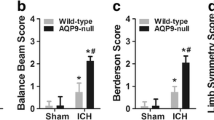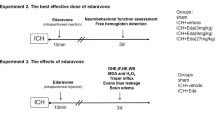Abstract
To investigate the effects of different atmosphere absolutes (ATA) of high-pressure oxygen (HPO) on brain tissue water content and Aquaporin-4 (AQP4) expression in rabbits with cerebral hemorrhage. 180 New Zealand white rabbits were selected and randomly divided into normal group (n = 30), control group (n = 30) and cerebral hemorrhage group (n = 120), and cerebral hemorrhage group was divided into group A, B, C and D with 30 rabbits in each group. The groups received 1.0, 1.8, 2.0 and 2.2 ATA of HPO treatments, respectively. Ten rabbits in each group were killed at first, third and fifth day to detect the brain tissue water content and change of AQP4 expression. In cerebral hemorrhage group, brain tissue water content and AQP4 expression after model establishment were first increased, then decreased and reached the maximum on third day (p < 0.05). Brain tissue water content and AQP4 expression in control group and cerebral hemorrhage group were significantly higher than normal group at different time points (p < 0.05). In contrast, brain tissue water content and AQP4 expression in group C were significantly lower than in group A, group B, group D and control group (p < 0.05). In control group, AQP4-positive cells significantly increased after model establishment, which reached maximum on third day, and positive cells in group C were significantly less than in group A, group B and group D. We also found that AQP4 expression were positively correlated with brain tissue water content (r = 0.719, p < 0.05) demonstrated by significantly increased AQP4 expression along with increased brain tissue water content. In conclusion, HPO can decrease AQP4 expression in brain tissue of rabbits with cerebral hemorrhage to suppress the progression of brain edema and promote repairing of injured tissue. 2.0 ATA HPO exerts best effects, which provides an experimental basis for ATA selection of HPO in treating cerebral hemorrhage.


Similar content being viewed by others
References
Bonomini, F., & Rezzani, R. (2010). Aquaporin and blood brain barrier. Current Neuropharmacology, 8(2), 92–96.
Cao, H., Ju, K., Zhong, L., & Meng, T. (2013). Efficacy of hyperbaric oxygen treatment for depression in the convalescent stage following cerebral hemorrhage. Experimental and Therapeutic Medicine, 5(6), 1609–1612.
Chen, C. H., Manaenko, A., Zhan, Y., Liu, W. W., Ostrowki, R. P., Tang, J., et al. (2010). Hydrogen gas reduced acute hyperglycemia-enhanced hemorrhagic transformation in a focal ischemia rat model. Neuroscience, 169(1), 402–414.
Chiu, C. D., Chen, C. C., Shen, C. C., Chin, L. T., Ma, H. I., Chuang, H. Y., et al. (2013). Hyperglycemia exacerbates intracerebral hemorrhage via the downregulation of aquaporin-4: temporal assessment with magnetic resonance imaging. Stroke; A Journal of Cerebral Circulation, 44(6), 1682–1689.
Chu, H., Tang, Y., & Dong, Q. (2014). Protection of granulocyte-colony stimulating factor to hemorrhagic brain injuries and its involved mechanisms: effects of vascular endothelial growth factor and aquaporin-4. Neuroscience, 260, 59–72.
Cui XN, Li YB, Li Y. (2012). [Effects of herbs capable of activating blood circulation or inducing diuresis on the expressions of tumor necrosis factor-alpha, nuclear factor-kappaB, and aquaporin-4 in rats with intracerebral hemorrhage]. Zhongguo Zhong xi yi jie he za zhi Zhongguo Zhongxiyi jiehe zazhi = Chinese Journal of Integrated Traditional and Western medicine/Zhongguo Zhong xi yi jie he xue hui, Zhongguo Zhong yi yan jiu yuan zhu ban, 32(2), 203–208. Epub 2012/05/12.
Feng, G., Xu, X., Wang, Q., Liu, Z., Li, Z., & Liu, G. (2010). The protective effects of calcitonin gene-related peptide on gastric mucosa injury after cerebral ischemia reperfusion in rats. Regulatory Peptides, 160(1–3), 121–128.
Guillard, E., Nancy, B., Floch, H., Henckes, A., Cochard, G., Arvieux, J., et al. (2010). Intracerebral hemorrhage related to systemic gas embolism during hysteroscopy. Undersea & Hyperbaric Medicine: Journal of the Undersea and Hyperbaric Medical Society, Inc., 37(2), 89–93.
Kuppers-Tiedt, L., Manaenko, A., Michalski, D., Guenther, A., Hobohm, C., Wagner, A., et al. (2011). Combined systemic thrombolysis with alteplase and early hyperbaric oxygen therapy in experimental embolic stroke in rats: relationship to functional outcome and reduction of structural damage. Acta Neurochirurgica Supplement., 111, 167–172.
Lee, L. C., Lieu, F. K., Chen, Y. H., Hung, T. H., & Chen, S. F. (2012). Tension pneumocephalus as a complication of hyperbaric oxygen therapy in a patient with chronic traumatic brain injury. American Journal of Physical Medicine & Rehabilitation/Association of Academic Physiatrists., 91(6), 528–532.
Lekic, T., Manaenko, A., Rolland, W., Ostrowski, R. P., Virbel, K., Tang, J., et al. (2011). Beneficial effect of hyperbaric oxygenation after neonatal germinal matrix hemorrhage. Acta Neurochirurgica Supplement., 111, 253–257.
Li, W., Hu, B., Li, G. L., Zhao, X. Q., Xin, B. Z., Lin, J. X., et al. (2012). Heterozygote genotypes at rs2222823 and rs2811712 SNP loci are associated with cerebral small vessel disease in Han Chinese population. CNS Neuroscience & Therapeutics, 18(7), 558–565.
Li, W. A., Moore-Langston, S., Chakraborty, T., Rafols, J. A., Conti, A. C., & Ding, Y. (2013). Hyperglycemia in stroke and possible treatments. Neurological Research, 35(5), 479–491.
Li, Z., Gao, C., Wang, Y., Liu, F., Ma, L., Deng, C., et al. (2011). Reducing pulmonary injury by hyperbaric oxygen preconditioning during simulated high altitude exposure in rats. The Journal of Trauma, 71(3), 673–679.
Manaenko, A., Fathali, N., Khatibi, N. H., Lekic, T., Hasegawa, Y., Martin, R., et al. (2011). Arginine-vasopressin V1a receptor inhibition improves neurologic outcomes following an intracerebral hemorrhagic brain injury. Neurochemistry International, 58(4), 542–548.
Manaenko, A., Lekic, T., Zhang, J. H., & Tang, J. (2011). NC1900, an arginine vasopressin analogue, fails to reduce brain edema and improve neurobehavioral deficits in an intracerebral hemorrhagic stroke mice model. Acta Neurochirurgica Supplement, 111, 155–159.
Matchett, G. A., Martin, R. D., & Zhang, J. H. (2009). Hyperbaric oxygen therapy and cerebral ischemia: Neuroprotective mechanisms. Neurological Research, 31(2), 114–121.
Michel-Monigadon, D., Bonny, C., & Hirt, L. (2010). c-Jun N-terminal kinase pathway inhibition in intracerebral hemorrhage. Cerebrovascular Diseases, 29(6), 564–570.
Ostrowski, R. P., & Zhang, J. H. (2011). Hyperbaric oxygen for cerebral vasospasm and brain injury following subarachnoid hemorrhage. Translational Stroke Research, 2(3), 316–327.
Pang, L., Wu, Y., Dong, N., Xu, D. H., Wang, D. W., Wang, Z. H., et al. (2014). Elevated serum ubiquitin C-terminal hydrolase-L1 levels in patients with carbon monoxide poisoning. Clinical Biochemistry, 47(1–2), 72–76.
Qing, W. G., Dong, Y. Q., Ping, T. Q., Lai, L. G., Fang, L. D., Min, H. W., et al. (2009). Brain edema after intracerebral hemorrhage in rats: The role of iron overload and aquaporin 4. Journal of Neurosurgery, 110(3), 462–468.
Ritzenthaler, T., Dailler, F., Vukusic, S., Confavreux, C., & Marignier, R. (2011). First attack of Devic’s neuromyelitis optica following endovascular treatment and rupture of brain arteriovenous malformation. Multiple Sclerosis, 17(7), 895–896.
Soejima, Y., Hu, Q., Krafft, P. R., Fujii, M., Tang, J., & Zhang, J. H. (2013). Hyperbaric oxygen preconditioning attenuates hyperglycemia-enhanced hemorrhagic transformation by inhibiting matrix metalloproteinases in focal cerebral ischemia in rats. Experimental Neurology, 247, 737–743.
Sun, L., Zhou, W., Mueller, C., Sommer, C., Heiland, S., Bauer, A. T., et al. (2010). Oxygen therapy reduces secondary hemorrhage after thrombolysis in thromboembolic cerebral ischemia. Journal of Cerebral Blood Flow and Metabolism: Official Journal of the International Society of Cerebral Blood Flow and Metabolism, 30(9), 1651–1660.
Sun, Z., Zhao, Z., Zhao, S., Sheng, Y., Gao, C., Li, J., et al. (2009). Recombinant hirudin treatment modulates aquaporin-4 and aquaporin-9 expression after intracerebral hemorrhage in vivo. Molecular Biology Reports, 36(5), 1119–1127.
Tait, M. J., Saadoun, S., Bell, B. A., Verkman, A. S., & Papadopoulos, M. C. (2010). Increased brain edema in aqp4-null mice in an experimental model of subarachnoid hemorrhage. Neuroscience, 167(1), 60–67.
Tang, Y., Wu, P., Su, J., Xiang, J., Cai, D., & Dong, Q. (2010). Effects of Aquaporin-4 on edema formation following intracerebral hemorrhage. Experimental Neurology, 223(2), 485–495.
Tekle, W. G., Adkinson, C. D., Chaudhry, S. A., Jadhav, V., Hassan, A. E., Rodriguez, G. J., et al. (2013). Factors associated with favorable response to hyperbaric oxygen therapy among patients presenting with iatrogenic cerebral arterial gas embolism. Neurocritical Care, 18(2), 228–233.
Wajima, D., Nakagawa, I., Nakase, H., & Yonezawa, T. (2013). Neuroprotective effect of suppression of astrocytic activation by arundic acid on brain injuries in rats with acute subdural hematomas. Brain Research, 1519, 127–135.
Wang, Z., Meng, C. J., Shen, X. M., Shu, Z., Ma, C., Zhu, G. Q., et al. (2012). Potential contribution of hypoxia-inducible factor-1 alpha, aquaporin-4, and matrix metalloproteinase-9 to blood-brain barrier disruption and brain edema after experimental subarachnoid hemorrhage. Journal of Molecular Neuroscience: MN, 48(1), 273–280.
Author information
Authors and Affiliations
Corresponding author
Rights and permissions
About this article
Cite this article
Wu, J., Chen, J., Guo, H. et al. Effects of High-Pressure Oxygen Therapy on Brain Tissue Water Content and AQP4 Expression in Rabbits with Cerebral Hemorrhage. Cell Biochem Biophys 70, 1579–1584 (2014). https://doi.org/10.1007/s12013-014-0098-y
Published:
Issue Date:
DOI: https://doi.org/10.1007/s12013-014-0098-y




